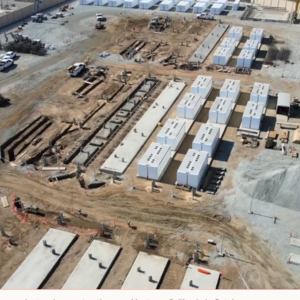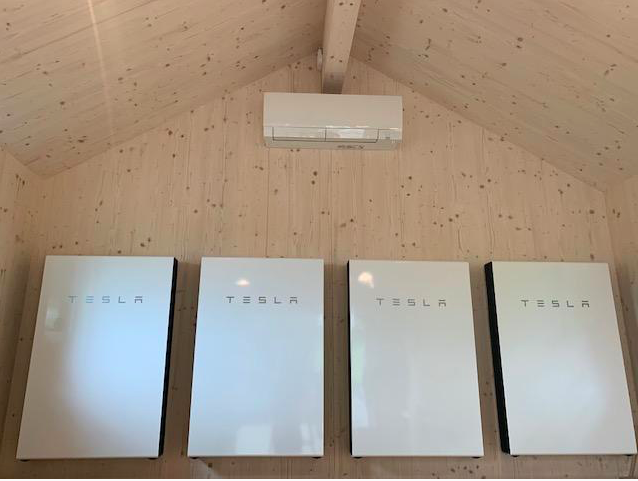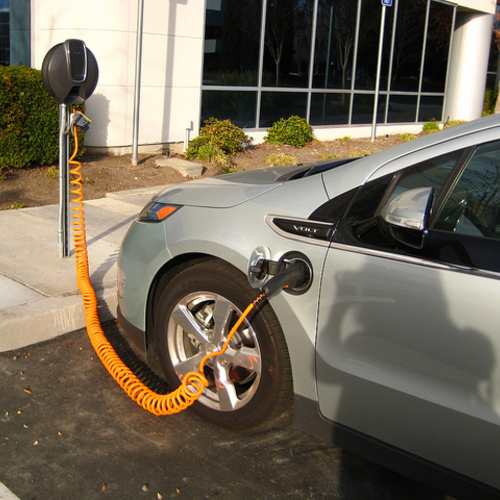
This article originally appeared at Yale Environment 360.
Sixteen years have passed since engineer Martin Eberhard unveiled his futuristic custom-designed sports car before a crowd of investors, journalists, and potential buyers in a Santa Monica Airport hangar. The Roadster, as it was called, contained a lot of innovative engineering, but nothing about it mattered more than the 6,831 lithium-ion battery cells packed into its rear compartment, which gave the vehicle its range and speed. “The battery system is the secret,” Eberhard explained at the time, “behind our four-second 0-60 mph acceleration.”
Eberhard and his collaborator, Marc Tarpenning, named their new electric vehicle company after Nikola Tesla, and two years later, in 2008, the Tesla became the first commercially produced, lithium-ion-powered vehicle to hit the auto market. Lithium-ion, or li-ion, was a big step up from the nickel-metal hydride (Ni-MH) batteries that had been powering most hybrid and electric vehicles, including the wildly popular Prius. Lithium’s better energy density means a li-ion battery can store a third more watt-hours per kilogram than Ni-MH batteries can, which means they last longer and weigh less.
But the lithium battery still has serious drawbacks. It relies on imported critical minerals—not just lithium, but cobalt, copper, graphite, and nickel—that are acquired by hacking into mountains or by pumping scarce desert groundwater into ponds, then waiting for water to evaporate and leave the mineral behind. The Democratic Republic of Congo produces more than 70% of the world’s cobalt, often by exploiting child labor under unsafe working conditions. Other minerals come from countries with which the United States would prefer to loosen economic ties, including Russia, which provides 20% of the world’s dwindling stores of nickel, and China, which supplies virtually all the graphite used in EV batteries internationally.
“We don’t necessarily have the ability to get some minerals unless we go to places that are defined as not acceptable,” says Ben Prochazka, executive director of the Electrification Coalition, a nonprofit that works to move transportation away from fossil fuels. Soon, we may not be able to get certain minerals at all: China, for instance, has threatened to keep its graphite for its own prodigious battery industry; market analysts predict the global demand for lithium will exceed supply by 2030. “We have got to figure out a different way of making batteries,” says Prochazka.
Search for new battery technology underway
With state and federal mandates and incentives pushing auto companies to prioritize battery-powered vehicles in their fleets, and volatile gas prices moving more consumers toward zero-emission transportation, automakers and battery companies are rushing to do just that. They are working to develop different ways to make batteries while decreasing costs, increasing energy density—which translates to all-important longer driving range—and weaning the industry off what the U.S. government calls “foreign entities of concern.”
Batteries that replace so-called conflict minerals with domestic minerals have advanced beyond research and development to their testing phases; a battery that reduces cobalt in favor of nickel, manganese, and aluminum is already in commercial production; several companies are working on solid-state batteries, which use no potentially flammable liquids, and plans for gigafactories devoted to battery manufacturing in the U.S. abound.
The passage of two new federal laws, the 2022 Inflation Reduction Act (IRA) and the 2021 Infrastructure Investment and Jobs Act, is expected to move the industry along. The U.S. has offered a $7,500 tax credit to buyers of most new EVs since the end of 2009; but starting in 2023, the IRA ties that tax credit to certain requirements for sourcing of critical minerals and manufacturing of batteries. By 2029, only EVs with 80% of their minerals sourced within the U.S. or its allied nations and 100% North American-manufactured or -assembled components will qualify for the full credit.
Taken together, the bills stand to transform the electric vehicle battery industry and force innovation, much as the American Recovery and Reinvestment Act did in the 2010s, when Tesla secured a $465 million federal loan to complete development of its Modern S sedan and open its plant in Fremont, California. If cobalt and nickel are hard to get, Prochazka says, then “let’s make batteries that use less cobalt, or no cobalt. Or let’s make batteries that use less nickel.” China refines nearly all of the minerals used by battery makers, Prochazka adds, “so now we’ll have processing facilities in the U.S.” Last month, Nevada-based Panasonic Energy announced that in 2025 it would start making EV batteries from nickel recycled in that state.
Michael Maten, GM’s senior strategist for EV and energy policy says the change was coming whether Congress acted or not. In 2021, when GM CEO Mary Barra committed to go 100% electric by 2035, Maten says, “The first thing we said was, ‘Oh man, we’re going to need a lot of batteries.’” That led to taking a hard look at the supply chain and making “a concerted effort to onshore or nearshore that supply chain to make sure it’s sustainable.” Now, he says, “just about every month we bring on another partner to secure” critical minerals.
Failure is not an option, Maten says. “We’re transforming a 100-year-old business based on the internal combustion engine into an all-EV business. We want to make sure we’re around for another 100 years.”
Progress in the lab
On a video call, George Liddle, director of analytics for Lyten, a San Jose-based company that specializes in making composites for batteries, holds up a piece of paper with the edge facing outward. “That’s two-dimensional graphene,” he says, which is structurally similar to a soccer net laid flat, “only in nano form.” Liddle then crumples the paper into a ball. “If you do this, you end up with 3D graphene, which is 1,000 times more reactive, electrically and chemically” than the flat version.
Lyten began as a commercial endeavor to collect waste methane from oil fields, convert it to inert carbon and sequester it deep underground. “It turned out that the economics didn’t work at all for that,” Liddle tells me. The company pivoted to batteries when one of its researchers discovered that graphene derived from that carbon could be used as a buffer between lithium and sulfur inside a new kind of battery.
“Sulfur has roughly four times the potential energy storage of nickel, manganese, or cobalt,” Liddle says, “and it is literally dirt cheap—it’s a byproduct of petrochemical operations.” Oil drillers give it away by the ton. That no one has ever made a lithium-sulfur battery with a commercial application (although some have tried) speaks to how difficult it is to do. As cells within the battery charge and then discharge, lithium bonds with sulfur and is released as lithium ions. With each cycle, the compound goes through a series of complex chemical conversions until neither the lithium nor the sulfur remain in usable form. “The battery cycles about 100 times and then dies,” Liddle explains, “because it basically poisoned itself.”
Now Liddle mimes inserting a substance—sulfur—into the spaces of the balled-up paper, the stand-in for graphene. “It turns out that if you take the sulfur and embed it deep into the nano-crevices of graphene, it forces the conversion of lithium-sulfur to lithium and sulfur,” he says. Graphene splits the two chemicals up, so sulfur atoms and lithium ions don’t destroy the battery.
A battery cell can be thought of as a sandwich: A positively charged cathode and a negatively charged anode around an electrolyte that passes ions from one side to the other. The electrolyte is almost always a viscous organic solvent. The cells in Lyten’s battery have all those components, but structured a little bit differently. “You can think of our battery cell as a French dip,” Liddle says. “The electrolyte permeates the whole thing.”
Solid-state batteries, in contrast, use no electrolyte at all, swapping it out for a polymer or ceramic that serves the same function but without the flammability risk of organic solvents. Gasoline-powered cars catch fire more readily and more often than EVs outfitted with li-ion batteries. But li-ion batteries are uniquely vulnerable to a phenomenon known as “thermal runaway,” where the burning cell can’t throw off heat faster than it generates it. As firefighters in Florida learned after saltwater-soaked Teslas caught fire following Hurricane Ian’s storm surge, it takes an awful lot of water to put out a chemical fire—up to 40 times as much as it takes to extinguish a gasoline car’s fire.
A handful of automakers, including Ford and Mercedes-Benz, have partnerships with battery manufacturers to explore solid-state technology. Factorial Energy, which is about to open a new factory in Methuen, Mass., expects to roll out solid-state EV batteries sometime between 2028 and 2030.
Most batteries use liquid electrolytes for good reason, explains Ahmad Pesaran, chief energy storage engineer with the National Renewable Energy Laboratories. A fluid can flow into every empty space to maintain contact between anode and cathode. For a solid electrolyte to work, however, “you have to have really good surfaces that can merge together,” Pesaran says. The materials also need to withstand pressure without cracking—a tall order for the brittle ceramics used in some solid-state applications.
In fact, battery researchers are more likely to succeed in commercializing silicon anodes than they are to perfect a solid-state technology, some experts say. Silicon has potentially twice the energy density of graphite, which is typically used in lithium-ion batteries, and it’s much more widely available. (Silicon’s feedstock is sand.) A silicon-anode battery could be available in just a few years. The main challenge has been silicon’s tendency to expand as it charges and discharges. “The volume changes almost 300% if you’re doing it to its maximum capacity,” says Brian Cunningham, a technology development manager with the U.S. Department of Energy, “and that creates a lot of mechanical strain on the entire structure,” making it unlikely the battery could survive a commercial vehicle’s requisite charge-discharge cycles. “We’re engineering solutions to reduce that stress and strain,” he says.
A better idea than debating bleeding-edge technologies, GM’s Maten says, is to simply look at which materials store the most energy at the least cost and are obtainable without tearing up Indonesian coastal villages for nickel or relying on authoritarian regimes. Lithium-ion battery prices are volatile, but right now they cost somewhere around $150 per kilowatt-hour. For cost parity with gasoline-powered engines, that price has to come down to at least $100 per kilowatt-hour, although some automakers are eyeing $60 per kilowatt-hour. There are many ways to get there, but no one knows when it will happen. “All of this is still very much in a lab setting,” Maten says.
In the real world, the people who buy vehicles will be the ultimate arbiters of successful battery technology, the DOE’s Cunningham says. What matters is creating a battery that will outperform drivers’ expectations for range and acceleration at a cost that makes the electric- vs. gas-powered debate moot. “At some point we’ll hit this crossover point where battery-electric vehicles are cheaper than conventional ones,” he says. He doesn’t much care how we get there—solid-state, silicon, or some other innovative battery design. The U.S. Department of Energy, he notes, is “chemistry agnostic.”
More federal funds available
In October, the DOE announced $2.8 billion in grants for 20 different companies working to bolster the production and processing of critical minerals in the U.S. Another round of funding for specific ventures will be announced in January. Jigar Shah, director of the loan programs office at the DOE, said in a video aimed at researchers and manufacturers that the IRA added $40 billion to the agency’s loan authority to support the Advanced Vehicle Manufacturing Program. “The goal of the program is really to onshore and reshore the supply chain for the automotive sector as we decarbonize here in this country,” he said. On December 12, the DOE awarded a $2.5 billion loan to Ultium Cells, a joint venture between GM and LG Energy Solution that will produce low-cobalt batteries at three U.S. facilities.
It’s important to note that simply building an electric vehicle supply chain within the U.S. and its allied nations doesn’t make it sustainable, at least not in the ecological and public health sense. Chile is technically a U.S.-friendly nation, yet lithium mining in the Atacama Desert threatens groundwater and drains lagoons on which local communities and wildlife depend. Ninety-seven percent of all nickel reserves in the U.S. are located within 35 miles of Native American communities, as are 89% of copper reserves.
Even in Southern California’s Imperial Valley, where lithium extraction—from the brine already being pumped into 11 geothermal power plants—has been heralded as a potential economic boon to a struggling agricultural community, environmental justice advocates worry about potential negative impacts. With a population of 179,000, the Imperial Valley is more than 85% Latino and has long suffered the health effects of pesticide drift from farm fields and airborne particulates from the dying Salton Sea. The impacts of lithium mining on public health have yet to be explored.
The California Energy Commission estimates that “Lithium Valley,” as it calls the Imperial Valley project, could supply as much as 40% of the world’s lithium demand, and it has already invested $16.5 million in developing the resource. Which means lithium production will likely go forward no matter what. Lithium, as Elon Musk is fond of saying, is indeed the new oil.
Whatever the drawbacks, the acquisition of lithium—no matter where it is found—probably won’t slow down. Not only does our dependence on gas and diesel engines harm the climate and our lungs, says the Electrification Coalition’s Prochazka, it’s a major national security risk. “We continue to export billions of dollars on an annual basis to countries that don’t share our ideals,” he notes. Battery technology may not be in every sense benign, but “we have much greater control over how we generate electrons” than we do over where we get our oil. “The future of transportation,” he says, “is electrification. That debate is over.”
Judith Lewis Mernit writes about energy, the environment, and social justice from Los Angeles, California.
Weekly Newsletter
Get building science and energy efficiency advice, plus special offers, in your inbox.















4 Comments
Interesting article. One thing that isn't mentioned is lithium-iron-phosphate (LiFePO) batteries that are already being used in EV's. The energy density is lower than other lithium chemistries, but it's safer, cheaper, and uses more commonly found elements. And the energy density has been slowly improving over the years.
The author wrote, "Lithium-ion battery prices are volatile, but right now they cost somewhere around $150 per kilowatt-hour. For cost parity with gasoline-powered engines, that price has to come down to at least $100 per kilowatt-hour."
I think she meant "at most," not "at least."
It seems that every week there is an announcement of a "game changing" new battery technology. The problem is getting the tech from the lab to production at scale. Even "simple" changes, like increasing a battery cell's size can prove tremendously difficult. Tesla's move from 2170 (21mm diameter, 70mm long) to 4680 has been fraught. Silicon anodes are still bound to the lab. Battery makers are taking baby steps by including a few percent silicone in their anode recipes. The current 4680 contains no silicon. Four years ago Tesla acquired Maxwell Technologies for their cheaper cleaner better dry electrode process but has only managed to apply it to the 4680's anode, relegating the cathode to the mature wet coating process.
Since Tesla's original Roadster introduction in 2008 Li-ion (lithium ion) battery prices have declined by an order of magnitude but BEVs (battery electric vehicles) have yet to achieve price parity with ICE (internal combustion engine) cars. Could the Roadster even been possible without decades of Li-ion battery development for the cell phone industry? Any disruptive new battery tech will face the same cost curve. It is difficult to imagine a marginally better yet initially much more expensive battery threatening Li-ion's dominance.
Certainly countries should develop domestic supply chains for security reasons, but a reason they haven't is that it is less expensive to acquire them overseas. Doesn't it make sense to buy China's resources cheap and leave ours in the ground for later?
We need a lot of batteries. We will be digging battery materials out of the ground for a long time to come. However, nearly all of the minerals are recycled when a Li-ion battery is exhausted. This will provide further headwinds to competing tech.
While it is interesting to learn of this large variety of chemistries, this article is not up to date on the two chemistries that presently have the greatest ability to scale, and also offer very long cycle life. These are: lithium ion and sodium ion.
For an excellent analysis of the trends in these two chemistries, I recommend a video that came out 6 months ago from Jordan of The Limiting Factor on Youtube.
The video goes over the large variety of materials that can be combined in the anode of these batteries and shows that Sodium combined with Manganese and a few other more common elements has the greatest potential to be scaled in the event that Lithium is too expensive. Lithium still seems like the better choice for mobile applications, although some of the sodium chemistries can work better in the cold. It is possible that companies will develop a hybrid battery.
Here is the link:
Sodium Ion // CATL and Faradion // Managing Expectations
https://www.youtube.com/watch?v=Nqp3T-MLskw
Log in or create an account to post a comment.
Sign up Log in